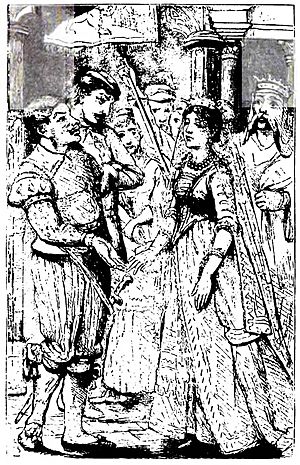The Most Incredible Thing facts for kids
- For the Pet Shop Boys album of the same name, see The Most Incredible Thing (album)
Quick facts for kids "The Most Incredible Thing" |
|
|---|---|
| Author | Hans Christian Andersen |
| Original title | "Det Utroligste" |
| Translator | Horace Scudder |
| Country | Denmark |
| Language | Danish |
| Genre(s) | Literary fairy tale |
| Published in | Nyt Dansk Maanedsskrift |
| Publisher | C.A. Reitzel |
| Media type | |
| Publication date | October 1870 (Denmark) |
| Published in English | September 1870 (United States) |
The Most Incredible Thing (Danish: Det Utroligste) is a special kind of fairy tale written by the famous Danish author Hans Christian Andersen (1805–1875). This story is about a competition to find the most amazing thing. It also shows the surprising events that happen after the winner is chosen.
The tale first appeared in English in the United States in September 1870. It was translated by Horace Scudder, who was a friend of Andersen's. The original Danish version was published in Denmark a month later, in October 1870. Andersen thought this story was one of his very best.
Contents
What the Story Is About
The story begins with a big announcement. The king says that whoever can create the most incredible thing will win half the kingdom. They will also get to marry the princess!
A young, poor man creates a truly amazing clock. It has different lifelike figures that appear when the hour strikes. These figures include Moses, Adam and Eve, the Four Seasons, and the Five Senses. Everyone agrees that this clock is the most incredible thing. The young man is named the winner.
Suddenly, another man appears and smashes the beautiful clock! Everyone then agrees that destroying the clock was even more incredible than creating it. So, the destroyer is chosen to marry the princess instead.
But at the wedding, something magical happens. The figures from the broken clock reappear! They defeat the destroyer and then vanish again. Everyone agrees that this is the most incredible thing of all. In the end, the princess marries the young man who created the amazing clock.
The Clock's Special Figures
Each hour on the clock features a different figure. These figures come from the Bible, old myths, or everyday life.
- One o'clock: Moses, writing the first of the Ten Commandments.
- Two o'clock: Adam and Eve, the first two people.
- Three o'clock: The Three Wise Men, who visited baby Jesus.
- Four o'clock: The Four Seasons, shown by a cuckoo bird (spring), a grasshopper (summer), an empty stork's nest (autumn), and an old crow (winter).
- Five o'clock: The Five Senses, shown by a spectacle maker (sight), a coppersmith (hearing), a flower girl (smell), a cook (taste), and an undertaker (touch).
- Six o'clock: A gambler, who always rolled sixes on dice.
- Seven o'clock: The seven days of the week, or the seven deadly sins.
- Eight o'clock: A choir of eight singing monks.
- Nine o'clock: The Muses of Greek mythology, who inspire arts and sciences.
- Ten o'clock: Moses returns with the rest of the Ten Commandments.
- Eleven o'clock: Eleven children playing and singing a rhyme.
- Twelve o'clock: A night watchman announcing the birth of Christ.
This story is completely original to Andersen. It is not based on any old folk tales. Andersen was inspired to write it because he was upset about the wars happening in Europe. He loved German culture, but he was sad to see how much the country had changed. He felt heartbroken that he might have to stop being friends with his German friends.
Impact of the Story
"The Most Incredible Thing" was the first Andersen story published in Denmark during the Nazi occupation. The introduction to a July 1940 edition suggested that Andersen wrote the tale with a lot of worry. But it also said he had a deep belief in the future.
In 1942, the story was included in a book put together by scholars. These scholars later became leaders of the Danish Resistance Movement. This group worked against the occupation. In the last picture for the 1942 edition, the night watchman is shown as a wise, bearded man. He strikes down the strong, bare-chested destroyer of the clock. A crowd of Danes, dressed in clothes from the 1940s, watches. This image showed a message of hope and strength during a difficult time.
Stage Shows and Ballets
The story has been adapted for the stage several times.
Pet Shop Boys Ballet
In 2011, the British pop group Pet Shop Boys created music for a ballet based on the story. It opened in March 2011 at Sadler's Wells Theatre in London. The story was adapted by Matthew Dunster. Javier de Frutos created the dances. The ballet starred Ivan Putrov, a former dancer from the Royal Ballet. It also featured animated films by Tal Rosner. This ballet won an Evening Standard Theatre Award. It returned to Sadler's Wells for a second season in 2012.
In 2018, the Charlotte Ballet in the United States performed this same ballet for the first time in America.
Other Productions
In 2016, the New York City Ballet also premiered a one-act ballet based on the story. This version was choreographed by Justin Peck.


